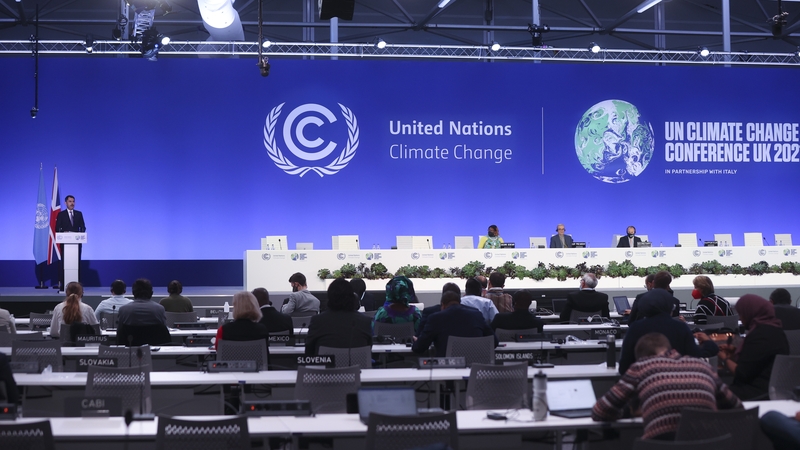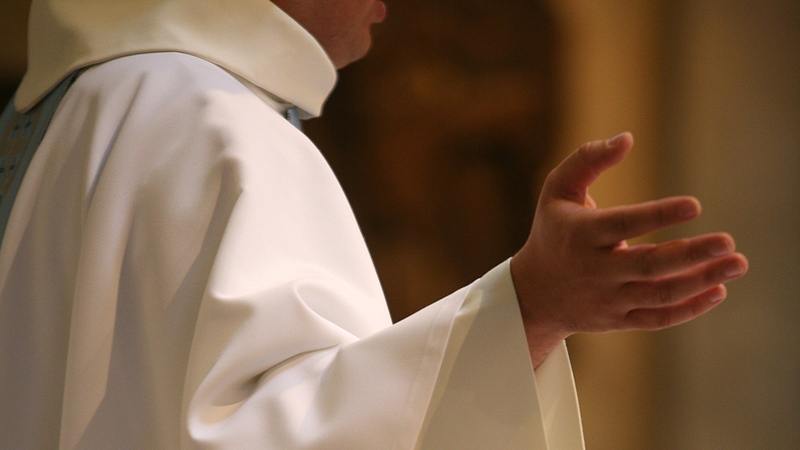Updated / Wednesday, 10 Nov 2021

Negotiators from nearly 200 countries will work from the draft
The United Nations climate agency has published a first draft of the political decision countries will issue at the end of the COP26 summit.
Negotiators from nearly 200 countries will work from the draft to strike a final deal before the summit ends on Friday.
The "COP cover decision" is being closely watched for what it might commit countries to do to bridge the gap between their current climate targets and the more ambitious action scientists say is needed to avert disastrous levels of warming.
Negotiators are also trying to hammer out agreement on technical parts of the global climate treaty, the Paris Agreement, including common timeframes for national commitments on emissions reductions and agreed ways for countries to report on their progress, to help turn pledges into action.
There are also negotiations on providing finance for developing countries to cope with climate change and address the issue of loss and damage to people, livelihoods, land and infrastructure caused by global warming in poorer nations.
British Prime Minister Boris Johnson has urged countries to "pull out all the stops" in the final days of COP26.
He is returning to the Glasgow summit today and will be joined by the UN Secretary General Antonio Guterres in meeting with heads of delegations and other groups.
Countries are positioning themselves for the final days of negotiations, with Nick Mabey from climate think tank E3G suggesting "a high ambition outcome is still on the table" and momentum is with those countries pushing for ambition.
A "High Ambition Coalition" of vulnerable countries and others including the US and Europe countries is calling for nations to submit action plans in line with limiting temperatures to 1.5C in the next year and long term plans to meet the target by 2023, though there is pushback from other countries.
Finance for developing countries is also key to the talks.
Minister for Foreign Affairs Simon Coveney is also due to travel to Glasgow.
He is expected to speak at an event in support of small island developing states, one of the groups of countries already dealing with the consequences of global warming.
The United Nations climate agency has published a first draft of the political decision countries will issue at the end of the COP26 summit.
Negotiators from nearly 200 countries will work from the draft to strike a final deal before the summit ends on Friday.
The "COP cover decision" is being closely watched for what it might commit countries to do to bridge the gap between their current climate targets and the more ambitious action scientists say is needed to avert disastrous levels of warming.
Negotiators are also trying to hammer out agreement on technical parts of the global climate treaty, the Paris Agreement, including common timeframes for national commitments on emissions reductions and agreed ways for countries to report on their progress, to help turn pledges into action.
There are also negotiations on providing finance for developing countries to cope with climate change and address the issue of loss and damage to people, livelihoods, land and infrastructure caused by global warming in poorer nations.
British Prime Minister Boris Johnson has urged countries to "pull out all the stops" in the final days of COP26.
He is returning to the Glasgow summit today and will be joined by the UN Secretary General Antonio Guterres in meeting with heads of delegations and other groups.
Countries are positioning themselves for the final days of negotiations, with Nick Mabey from climate think tank E3G suggesting "a high ambition outcome is still on the table" and momentum is with those countries pushing for ambition.
A "High Ambition Coalition" of vulnerable countries and others including the US and Europe countries is calling for nations to submit action plans in line with limiting temperatures to 1.5C in the next year and long term plans to meet the target by 2023, though there is pushback from other countries.
Finance for developing countries is also key to the talks.
Minister for Foreign Affairs Simon Coveney is also due to travel to Glasgow.
He is expected to speak at an event in support of small island developing states, one of the groups of countries already dealing with the consequences of global warming.
Climate talks draft agreement expresses ‘alarm and concern’
By SETH BORENSTEIN and FRANK JORDANS

1 of 7
Extinction Rebellion climate campaigners take part in a 24-hour vigil protest outside offices of the JP Morgan bank as the COP26 U.N. Climate Summit takes place in Glasgow, Scotland, Wednesday, Nov. 10, 2021. The U.N. climate summit in Glasgow has entered its second week as leaders from around the world, are gathering in Scotland's biggest city, to lay out their vision for addressing the common challenge of global warming. (AP Photo/Alastair Grant)
GLASGOW, Scotland (AP) — Negotiators at the United Nations climate talks are considering a draft decision that highlights “alarm and concern” about global warming the planet already is experiencing and continues to call on the world to cut about half of its emissions of heat-trapping gases by 2030.
The early version of the cover decision released Wednesday at the climate talks in Glasgow, Scotland, doesn’t provide specific agreements on the three major goals that the U.N. set going into the negotiations.
The draft mentions the need to cut emissions by 45% by 2030 from 2010 levels and achieve “net-zero” by mid-century. Doing so requires countries to pump only as much greenhouse gas into the atmosphere as can be absorbed again through natural or artificial means.
It urges countries to “accelerate the phasing out of coal and subsidies for fossil fuels,” but makes no explicit reference to ending the use of oil and gas.
The draft also acknowledges “with regret” that rich nations have failed to live up to their pledge of providing $100 billion a year in financial help by 2020 to help poor nations dead with global warming.
The draft reaffirms the goals set in Paris in 2015 of limiting warming to 2 degrees Celsius (3.6 degrees Fahrenheit) since pre-industrial times, with a more stringent target of trying to keep warming to 1.5 degrees Celsius (2.7 degrees Fahrenheit) preferred.
Highlighting the challenge of meeting those goals, the document “expresses alarm and concern that human activities have caused around 1.1 C (2 F) of global warming to date and that impacts are already being felt in every region.”
Separate draft proposals were also released on other issues being debated at the talks, including rules for international carbon markets and the frequency by which countries have to report on their efforts.
The draft calls on nations that don’t have national goals that would fit with the 1.5 or 2 degree temperature rise limits to come back with stronger targets next year. Depending on the language is interpreted, the provision could apply to most countries. Analysts at the World Resources Institute counted this element of the draft as a win for vulnerable countries.
“This is crucial language,” WRI International Climate Initiative Director David Waskow said Wednesday. “Countries really are expected and are on the hook to do something in that timeframe to adjust.’’
In a nod to one of the big issues for poorer countries, the draft vaguely “urges” developed nations to compensate developing countries for “loss and damage,” a phrase that some rich nations don’t like.
Whatever comes out of the meeting in Glasgow has to be unanimously approved by nearly 200 nations attending the negotiations.
A lot of negotiating and decision-making is to come in the next three or possibly four days. The deadline for the talks is Friday, but climate talks often go past planned end dates. The cover decisions provide more than anything the parameters for the issues that need to be resolved in the last few days of the annual U.N. conference, Waskow said.
___
Follow AP’s climate coverage at https://apnews.com/hub/climate
By SETH BORENSTEIN and FRANK JORDANS

1 of 7
Extinction Rebellion climate campaigners take part in a 24-hour vigil protest outside offices of the JP Morgan bank as the COP26 U.N. Climate Summit takes place in Glasgow, Scotland, Wednesday, Nov. 10, 2021. The U.N. climate summit in Glasgow has entered its second week as leaders from around the world, are gathering in Scotland's biggest city, to lay out their vision for addressing the common challenge of global warming. (AP Photo/Alastair Grant)
GLASGOW, Scotland (AP) — Negotiators at the United Nations climate talks are considering a draft decision that highlights “alarm and concern” about global warming the planet already is experiencing and continues to call on the world to cut about half of its emissions of heat-trapping gases by 2030.
The early version of the cover decision released Wednesday at the climate talks in Glasgow, Scotland, doesn’t provide specific agreements on the three major goals that the U.N. set going into the negotiations.
The draft mentions the need to cut emissions by 45% by 2030 from 2010 levels and achieve “net-zero” by mid-century. Doing so requires countries to pump only as much greenhouse gas into the atmosphere as can be absorbed again through natural or artificial means.
It urges countries to “accelerate the phasing out of coal and subsidies for fossil fuels,” but makes no explicit reference to ending the use of oil and gas.
The draft also acknowledges “with regret” that rich nations have failed to live up to their pledge of providing $100 billion a year in financial help by 2020 to help poor nations dead with global warming.
The draft reaffirms the goals set in Paris in 2015 of limiting warming to 2 degrees Celsius (3.6 degrees Fahrenheit) since pre-industrial times, with a more stringent target of trying to keep warming to 1.5 degrees Celsius (2.7 degrees Fahrenheit) preferred.
Highlighting the challenge of meeting those goals, the document “expresses alarm and concern that human activities have caused around 1.1 C (2 F) of global warming to date and that impacts are already being felt in every region.”
Separate draft proposals were also released on other issues being debated at the talks, including rules for international carbon markets and the frequency by which countries have to report on their efforts.
The draft calls on nations that don’t have national goals that would fit with the 1.5 or 2 degree temperature rise limits to come back with stronger targets next year. Depending on the language is interpreted, the provision could apply to most countries. Analysts at the World Resources Institute counted this element of the draft as a win for vulnerable countries.
“This is crucial language,” WRI International Climate Initiative Director David Waskow said Wednesday. “Countries really are expected and are on the hook to do something in that timeframe to adjust.’’
In a nod to one of the big issues for poorer countries, the draft vaguely “urges” developed nations to compensate developing countries for “loss and damage,” a phrase that some rich nations don’t like.
Whatever comes out of the meeting in Glasgow has to be unanimously approved by nearly 200 nations attending the negotiations.
A lot of negotiating and decision-making is to come in the next three or possibly four days. The deadline for the talks is Friday, but climate talks often go past planned end dates. The cover decisions provide more than anything the parameters for the issues that need to be resolved in the last few days of the annual U.N. conference, Waskow said.
___
Follow AP’s climate coverage at https://apnews.com/hub/climate










